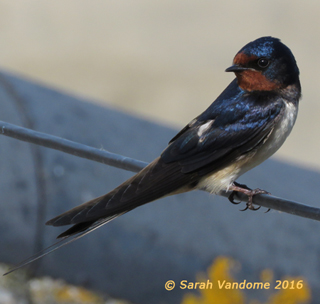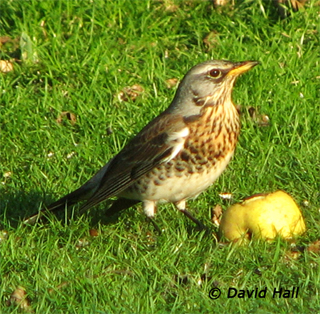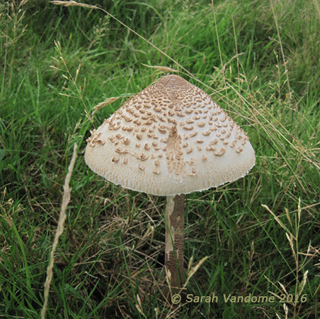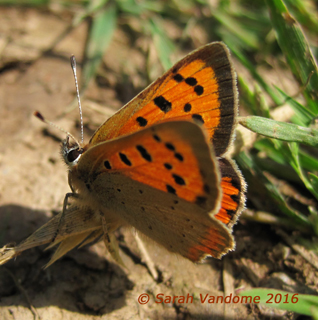 This month, as overwintering birds gather around Roseland shores, estuaries and farmland, David Hall considers the miracle of migration that brings them here.
This month, as overwintering birds gather around Roseland shores, estuaries and farmland, David Hall considers the miracle of migration that brings them here.
It’s a long time since the Victorian ornithologists believed that Swallows and Cuckoos went into a hibernating stupor in the mud at the bottom of ponds and marshes and actually stayed here! As the seasons change, so do our birds on the Roseland: and it is that time of year again, as summer visitors leave and winter visitors arrive. Migration is an amazing accomplishment for them all. The swallow leaves for South Africa, the manx shearwater for the South Atlantic off Argentina, and, amazingly, most of our small insect eating birds, like the whitethroat, fly to beyond the Sahara desert without their parents. They left first!
 By mid-September migration is in full flow. Breeding is over, feathers have been renewed, daylight is shortening, air-borne insect food diminishes, and temperatures drop. Migration usually takes place at times of high atmospheric pressure and often at night as the skies are clear and stars can be seen. Migrant routes have other dangers though when the weather changes. Depressions may arrive, with strong head or cross winds and rain to battle against. Then birds already in flight can become disorientated, landing where they can, including on ocean going ships and oil platforms, or are battered against lighthouses. The survivors move on.
By mid-September migration is in full flow. Breeding is over, feathers have been renewed, daylight is shortening, air-borne insect food diminishes, and temperatures drop. Migration usually takes place at times of high atmospheric pressure and often at night as the skies are clear and stars can be seen. Migrant routes have other dangers though when the weather changes. Depressions may arrive, with strong head or cross winds and rain to battle against. Then birds already in flight can become disorientated, landing where they can, including on ocean going ships and oil platforms, or are battered against lighthouses. The survivors move on.
 Listen after dark to the high pitched single whistle of redwings (above) or the clacking sound of fieldfares (left) pouring from Scandinavia to gorge on autumn berries as they escape from even colder areas. Our population of thrushes, blackbirds, robins and starlings increases dramatically as birds arrive from central Europe to be in our milder maritime climate. Wintering divers and grebes come to feed and shelter in our estuaries and bays, with numbers building up as winter approaches. Wigeon with their golden striped heads arrive from Siberia. Listen for their single piercing whistle as they feed on grasses in our marshes; and eventually goldeneye and saw-billed mergansers come onto our rivers.
Listen after dark to the high pitched single whistle of redwings (above) or the clacking sound of fieldfares (left) pouring from Scandinavia to gorge on autumn berries as they escape from even colder areas. Our population of thrushes, blackbirds, robins and starlings increases dramatically as birds arrive from central Europe to be in our milder maritime climate. Wintering divers and grebes come to feed and shelter in our estuaries and bays, with numbers building up as winter approaches. Wigeon with their golden striped heads arrive from Siberia. Listen for their single piercing whistle as they feed on grasses in our marshes; and eventually goldeneye and saw-billed mergansers come onto our rivers.
 Since late July some birds arrived on passage from the north, just visited, fattened up and then went south again. Many waders do this, although our geese flocks honking booms as they drop in skeins and the haunting cries of curlew are here for most of the winter. One spectacular passage migrant is the osprey which eats fish, and nothing else, by diving claws first into our rivers, usually at high tide when shoals of plentiful mullet are pushed by the water flow into ever narrowing concentrations up our estuaries. It’s a huge bird that startles all others, causing panic when it arrives on stiff, very long white underwings with its white-topped head clearly angled down as it tries to spot its next meal. They linger in the upper Fal area from mid-August onwards, but by mid-October are usually gone, via the length of the Nile, into central Africa.
Since late July some birds arrived on passage from the north, just visited, fattened up and then went south again. Many waders do this, although our geese flocks honking booms as they drop in skeins and the haunting cries of curlew are here for most of the winter. One spectacular passage migrant is the osprey which eats fish, and nothing else, by diving claws first into our rivers, usually at high tide when shoals of plentiful mullet are pushed by the water flow into ever narrowing concentrations up our estuaries. It’s a huge bird that startles all others, causing panic when it arrives on stiff, very long white underwings with its white-topped head clearly angled down as it tries to spot its next meal. They linger in the upper Fal area from mid-August onwards, but by mid-October are usually gone, via the length of the Nile, into central Africa.
On the sea-strand you may see groups of small waders, mainly dunlin, but sometimes with small white birds running along the sand at the wave edges. These are sanderling here from Greenland or Siberia. The sandwich terns have already gone. They travel to the west coast of Africa for the winter and won’t be back until mid-March.
How do we know all this? From still developing research we know that the trigger is length of daylight. Some of the migration movements are likely to be innate; while theories abound about the use of the stars or the magnetic forces of the earth being linked by some form of compass within the migratory birds, as also does the search for food, shelter and warmth elsewhere. In other words, it’s about survival. We know from bird-ringing studies where specific destinations are and these days, with larger birds, from wing tags and attached gps trackers. It still is a developing branch of ornithology. Witness the journey of the Dalmatian pelican, which arrived in Cornwall in early May. It’s still here making irregular appearances in the Ardevora region of the Fal when it should be in Greece. What mysteries explain that?
Event News
 Wild Roseland are planning a series of monthly events – Walks & Talks – to discover and enjoy the wildlife on our doorstep. These events will be suitable for all who are interested in nature, regardless of whether you are an expert, an amateur or just curious! Outdoor events will involve a ramble, sometime with rough or wet ground and the usual Cornish weather, so come prepared and dressed accordingly; we will indicate for each event the expected conditions and whether dogs are allowed by the site owner. Indoor events will be in the evening, in a village hall or other suitable venue, refreshments usually available.
Wild Roseland are planning a series of monthly events – Walks & Talks – to discover and enjoy the wildlife on our doorstep. These events will be suitable for all who are interested in nature, regardless of whether you are an expert, an amateur or just curious! Outdoor events will involve a ramble, sometime with rough or wet ground and the usual Cornish weather, so come prepared and dressed accordingly; we will indicate for each event the expected conditions and whether dogs are allowed by the site owner. Indoor events will be in the evening, in a village hall or other suitable venue, refreshments usually available.
Our first event is on Saturday 29th October 2016 – a Fungus Foray in woods alongside the River Fal near Ruan Lanihorne. This will be a joint event with the Cornwall Fungi Group and will be led by Pauline Penna of the CFG, so we will have experts on hand to help with identification. Note that we will be searching, observing and taking photos, not collecting for the cooking pot! This should be a nice ramble through the autumn woods, whether or not you are interested in Fungi, and will take about 2 hours. The woodland track is a reasonable path for walking, but some rummaging in undergrowth is likely; dogs allowed provided owners are well behaved and do not wander onto adjacent fields where there are livestock.
Meet at 10am at Sett Bridge (grid ref. SW 888 422; from Ruan Lanihorne take the road along the Ruan River towards Lamorran; park responsibly in the village or alongside the road). To help anticipate numbers please phone, text or email Nick on 07887 770574, ncoppin@gmail.com, if you would like to come along, and if you would like a lift there. A small donation of £2 from attendees would be welcomed!
Further events are being planned and we will circulate details later
Science News
 The United Kingdom Butterfly Monotoring Scheme (UKBMS), run by Butterfly Conservation, the Centre for Ecology and Hydrology, the BTO, and partner organizations, has published a report on 58 species of butterflies monitored in 2015. The news is not good for some 35 species, whose numbers have declined since 2014. The Small copper (depicted left), for example, which can be found in the Roseland, is down as much as 25{c8c3b3d140ed11cb7662417ff7b2dc686ffa9c2daf0848ac14f76e68f36d0c20}, part of a long term decline noted over the last 40 years. On the other hand, while 3 species showed no population change, the remaining 20 increased in number. The Holly blue, for example, which can also be found in the Roseland, has seen a population explosion in some areas.
The United Kingdom Butterfly Monotoring Scheme (UKBMS), run by Butterfly Conservation, the Centre for Ecology and Hydrology, the BTO, and partner organizations, has published a report on 58 species of butterflies monitored in 2015. The news is not good for some 35 species, whose numbers have declined since 2014. The Small copper (depicted left), for example, which can be found in the Roseland, is down as much as 25{c8c3b3d140ed11cb7662417ff7b2dc686ffa9c2daf0848ac14f76e68f36d0c20}, part of a long term decline noted over the last 40 years. On the other hand, while 3 species showed no population change, the remaining 20 increased in number. The Holly blue, for example, which can also be found in the Roseland, has seen a population explosion in some areas.
Several sites in the Roseland contributed to the survey outcome, including Treluggan Cliffs, Ruan Lanihorne, and Nare Head.
The downturn for the majority of species was thought mainly due to the poor summer of 2015.
________
Wild Roseland is a group of volunteers who care passionately about looking after the nature and landscape of the Roseland peninsula in south Cornwall. Through a number of initiatives and projects, the aim is to inspire and enhance the conservation of this special place for all.
Edited by Sarah E Vandome
Contributors:
Colin Hastings, David Hall, Nick Coppin, Sarah Vandome
Enjoy more Roseland wildlife and landscapes – visit Sarah Vandome’s Heart of Roseland Facebook feature:
https://www.facebook.com/HeartOfRoseland?ref=hl



